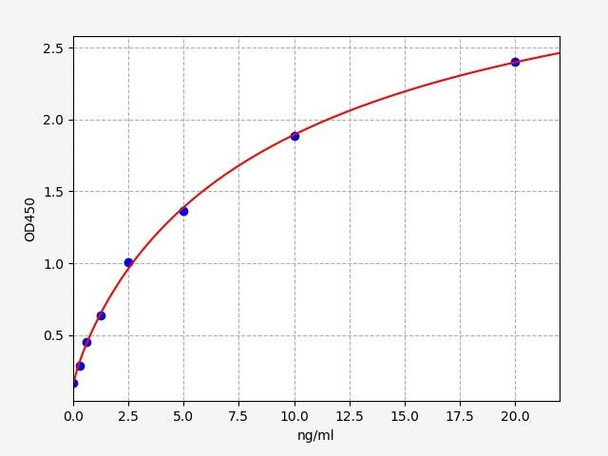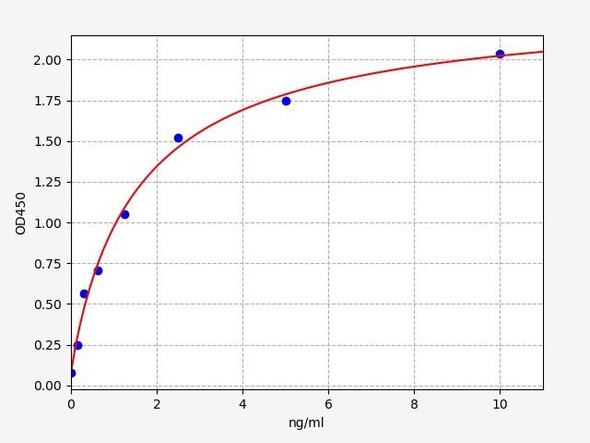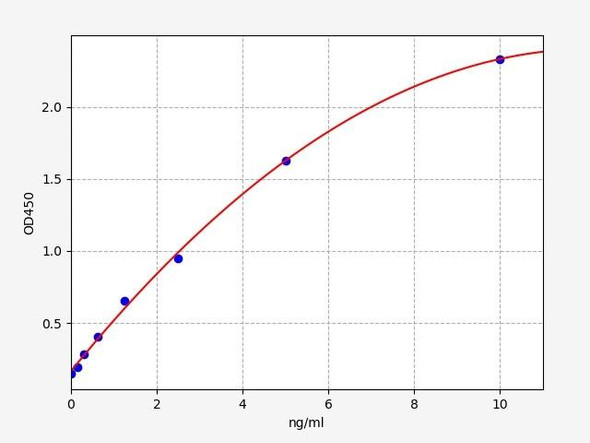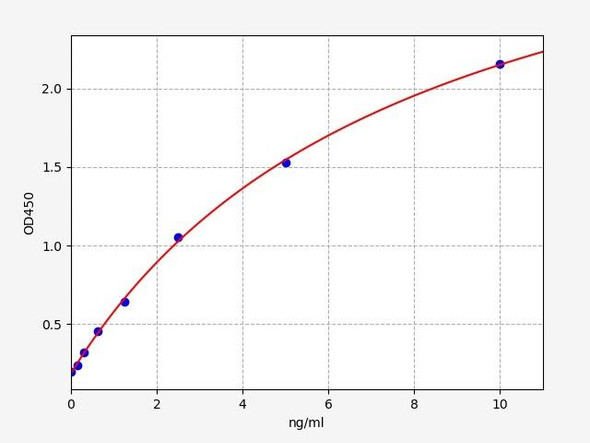Human Tankyrase 1 ELISA Kit
- SKU:
- HUFI02906
- Product Type:
- ELISA Kit
- Size:
- 96 Assays
- Uniprot:
- O95271
- Sensitivity:
- 0.188ng/ml
- Range:
- 0.313-20ng/ml
- ELISA Type:
- Sandwich
- Synonyms:
- TNKS1, PARP5A, PARPL, pART5, TANK1, TINF1, TNKS, EC 2.4.2.30, PARP-5a, PARP5APARPL, pART5, Poly [ADP-ribose] polymerase 5A, Tankyrase I, tankyrase, TRF1-interacting ankyrin-related ADP-ribose polymerase, tankyrase-1, TIN1TANK1, TINF1TNKS-1, TNKS1TRF1
- Reactivity:
- Human
- Research Area:
- Cell Cycle
Description
Human Tankyrase 1 ELISA
TNKS1 (Tankyrase) functions as an activator of the Wnt signalling pathway through the mediation of the poly-ADP-ribosylation (PARsylation) of AXIN1 and AXIN2. These are 2 key components of the beta-catenin destruction complex. this means that poly-ADP-ribosylated target proteins are recognized by RNF146 causing their ubiquitination and resulting degradation. Poly-ADP-ribosyltransferase is a protein that is involved in a number of processes, including the Wnt signalling pathway, telomere length, and vesicle transport. The PARsylation of BLZF1 and CASC3 is mediated by TNKS, this is then followed by the recruitment of RNF146 and subsequent its ubiquitination. In addition, PARsylation of TERK1 is mediated by TNKS, which plays a role in the regulation of telomere length. By regulating the PARsylation of HEPACAM2/MIKI, TKNKS is involved in prometaphase centrosome maturation.TAKS regulates vesicular transport and modulates the subcellular distribution of SLC2A4/GLUT4-vesicles. Spindle pole assembly may utilise TNKS via PARsylation of NUMA1. 26S proteasome activity is increased by TNKS. Lung acinar adenocarcinoma and cherubism are diseases that are associated with TNKS. The metabolism of protein and misspliced GSK3beta mutants stabilize beta-catenin are among the pathways related to TNKS. TNKS is noted in gene ontology annotations of NAD+ and ADP- ribosyltransferase activity. TNKS1 is a homolog of TNKS2.
| Product Name: | Human Tankyrase 1 ELISA Kit |
| Product Code: | HUFI02906 |
| Size: | 96 Assays |
| Alias: | TNKS1, PARP5A, PARPL, pART5, TANK1, TINF1, TNKS, EC 2.4.2.30, PARP-5a, PARP5APARPL, pART5, Poly [ADP-ribose] polymerase 5A, Tankyrase I, tankyrase, TRF1-interacting ankyrin-related ADP-ribose polymerase, tankyrase-1, TIN1TANK1, TINF1TNKS-1, TNKS1TRF1-interacting ankyrin-related ADP-ribose polymerase |
| Detection method: | Sandwich ELISA, Double Antibody |
| Application: | This immunoassay kit allows for the in vitro quantitative determination of Human TNKS1 concentrations in serum plasma and other biological fluids. |
| Sensitivity: | 0.188ng/ml |
| Range: | 0.313-20ng/ml |
| Storage: | 4°C for 6 months |
| Note: | For Research Use Only |
| Recovery: | Matrices listed below were spiked with certain level of Human TNKS1 and the recovery rates were calculated by comparing the measured value to the expected amount of Human TNKS1 in samples. | ||||||||||||||||
| |||||||||||||||||
| Linearity: | The linearity of the kit was assayed by testing samples spiked with appropriate concentration of Human TNKS1 and their serial dilutions. The results were demonstrated by the percentage of calculated concentration to the expected. | ||||||||||||||||
| |||||||||||||||||
| CV(%): | Intra-Assay: CV<8% Inter-Assay: CV<10% |
| Component | Quantity | Storage |
| ELISA Microplate (Dismountable) | 8×12 strips | 4°C for 6 months |
| Lyophilized Standard | 2 | 4°C/-20°C |
| Sample/Standard Dilution Buffer | 20ml | 4°C |
| Biotin-labeled Antibody(Concentrated) | 120ul | 4°C (Protect from light) |
| Antibody Dilution Buffer | 10ml | 4°C |
| HRP-Streptavidin Conjugate(SABC) | 120ul | 4°C (Protect from light) |
| SABC Dilution Buffer | 10ml | 4°C |
| TMB Substrate | 10ml | 4°C (Protect from light) |
| Stop Solution | 10ml | 4°C |
| Wash Buffer(25X) | 30ml | 4°C |
| Plate Sealer | 5 | - |
Other materials and equipment required:
- Microplate reader with 450 nm wavelength filter
- Multichannel Pipette, Pipette, microcentrifuge tubes and disposable pipette tips
- Incubator
- Deionized or distilled water
- Absorbent paper
- Buffer resevoir
| Uniprot | O95271 |
| UniProt Protein Function: | TNKS: Poly-ADP-ribosyltransferase involved in various processes such as Wnt signaling pathway, telomere length and vesicle trafficking. Acts as an activator of the Wnt signaling pathway by mediating poly-ADP-ribosylation (PARsylation) of AXIN1 and AXIN2, 2 key components of the beta-catenin destruction complex: poly-ADP-ribosylated target proteins are recognized by RNF146, which mediates their ubiquitination and subsequent degradation. Also mediates PARsylation of BLZF1 and CASC3, followed by recruitment of RNF146 and subsequent ubiquitination. Mediates PARsylation of TERF1, thereby contributing to the regulation of telomere length. Involved in centrosome maturation during prometaphase by mediating PARsylation of HEPACAM2/MIKI. May also regulate vesicle trafficking and modulate the subcellular distribution of SLC2A4/GLUT4-vesicles. May be involved in spindle pole assembly through PARsylation of NUMA1. 2 isoforms of the human protein are produced by alternative splicing. |
| UniProt Protein Details: | Protein type:EC 2.4.2.30; Transferase Chromosomal Location of Human Ortholog: 8p23.1 Cellular Component: Golgi membrane; spindle pole; Golgi apparatus; pericentriolar material; chromosome, telomeric region; nuclear membrane; nuclear chromosome, telomeric region; nuclear pore; cytosol; chromosome, pericentric region Molecular Function:protein binding; zinc ion binding; NAD+ ADP-ribosyltransferase activity Biological Process: mitosis; protein polyubiquitination; mRNA transport; Wnt receptor signaling pathway; peptidyl-threonine phosphorylation; spindle assembly; negative regulation of DNA binding; positive regulation of telomere maintenance via telomerase; peptidyl-serine phosphorylation; protein amino acid ADP-ribosylation; protein transport; mitotic spindle organization and biogenesis; cell division; positive regulation of transcription from RNA polymerase II promoter; regulation of telomere maintenance via telomerase |
| UniProt Code: | O95271 |
| NCBI GenInfo Identifier: | 226693566 |
| NCBI Gene ID: | 8658 |
| NCBI Accession: | O95271.2 |
| UniProt Related Accession: | O95271 |
| Molecular Weight: | 67kDa; 142kDa |
| NCBI Full Name: | Poly |
| NCBI Synonym Full Names: | tankyrase |
| NCBI Official Symbol: | TNKS |
| NCBI Official Synonym Symbols: | TIN1; ARTD5; PARPL; TINF1; TNKS1; pART5; PARP5A; PARP-5a |
| NCBI Protein Information: | poly [ADP-ribose] polymerase tankyrase-1 |
| UniProt Protein Name: | Tankyrase-1 |
| UniProt Synonym Protein Names: | ADP-ribosyltransferase diphtheria toxin-like 5; ARTD5; Poly [ADP-ribose] polymerase 5A; TNKS-1; TRF1-interacting ankyrin-related ADP-ribose polymerase; Tankyrase I |
| Protein Family: | Tankyrase |
| UniProt Gene Name: | TNKS |
| UniProt Entry Name: | TNKS1_HUMAN |
*Note: Protocols are specific to each batch/lot. For the correct instructions please follow the protocol included in your kit.
Before adding to wells, equilibrate the SABC working solution and TMB substrate for at least 30 min at 37°C. When diluting samples and reagents, they must be mixed completely and evenly. It is recommended to plot a standard curve for each test.
| Step | Protocol |
| 1. | Set standard, test sample and control (zero) wells on the pre-coated plate respectively, and then, record their positions. It is recommended to measure each standard and sample in duplicate. Wash plate 2 times before adding standard, sample and control (zero) wells! |
| 2. | Aliquot 0.1ml standard solutions into the standard wells. |
| 3. | Add 0.1 ml of Sample / Standard dilution buffer into the control (zero) well. |
| 4. | Add 0.1 ml of properly diluted sample ( Human serum, plasma, tissue homogenates and other biological fluids.) into test sample wells. |
| 5. | Seal the plate with a cover and incubate at 37 °C for 90 min. |
| 6. | Remove the cover and discard the plate content, clap the plate on the absorbent filter papers or other absorbent material. Do NOT let the wells completely dry at any time. Wash plate X2. |
| 7. | Add 0.1 ml of Biotin- detection antibody working solution into the above wells (standard, test sample & zero wells). Add the solution at the bottom of each well without touching the side wall. |
| 8. | Seal the plate with a cover and incubate at 37°C for 60 min. |
| 9. | Remove the cover, and wash plate 3 times with Wash buffer. Let wash buffer rest in wells for 1 min between each wash. |
| 10. | Add 0.1 ml of SABC working solution into each well, cover the plate and incubate at 37°C for 30 min. |
| 11. | Remove the cover and wash plate 5 times with Wash buffer, and each time let the wash buffer stay in the wells for 1-2 min. |
| 12. | Add 90 µl of TMB substrate into each well, cover the plate and incubate at 37°C in dark within 10-20 min. (Note: This incubation time is for reference use only, the optimal time should be determined by end user.) And the shades of blue can be seen in the first 3-4 wells (with most concentrated standard solutions), the other wells show no obvious color. |
| 13. | Add 50 µl of Stop solution into each well and mix thoroughly. The color changes into yellow immediately. |
| 14. | Read the O.D. absorbance at 450 nm in a microplate reader immediately after adding the stop solution. |
When carrying out an ELISA assay it is important to prepare your samples in order to achieve the best possible results. Below we have a list of procedures for the preparation of samples for different sample types.
| Sample Type | Protocol |
| Serum | If using serum separator tubes, allow samples to clot for 30 minutes at room temperature. Centrifuge for 10 minutes at 1,000x g. Collect the serum fraction and assay promptly or aliquot and store the samples at -80°C. Avoid multiple freeze-thaw cycles. If serum separator tubes are not being used, allow samples to clot overnight at 2-8°C. Centrifuge for 10 minutes at 1,000x g. Remove serum and assay promptly or aliquot and store the samples at -80°C. Avoid multiple freeze-thaw cycles. |
| Plasma | Collect plasma using EDTA or heparin as an anticoagulant. Centrifuge samples at 4°C for 15 mins at 1000 × g within 30 mins of collection. Collect the plasma fraction and assay promptly or aliquot and store the samples at -80°C. Avoid multiple freeze-thaw cycles. Note: Over haemolysed samples are not suitable for use with this kit. |
| Urine & Cerebrospinal Fluid | Collect the urine (mid-stream) in a sterile container, centrifuge for 20 mins at 2000-3000 rpm. Remove supernatant and assay immediately. If any precipitation is detected, repeat the centrifugation step. A similar protocol can be used for cerebrospinal fluid. |
| Cell culture supernatant | Collect the cell culture media by pipette, followed by centrifugation at 4°C for 20 mins at 1500 rpm. Collect the clear supernatant and assay immediately. |
| Cell lysates | Solubilize cells in lysis buffer and allow to sit on ice for 30 minutes. Centrifuge tubes at 14,000 x g for 5 minutes to remove insoluble material. Aliquot the supernatant into a new tube and discard the remaining whole cell extract. Quantify total protein concentration using a total protein assay. Assay immediately or aliquot and store at ≤ -20 °C. |
| Tissue homogenates | The preparation of tissue homogenates will vary depending upon tissue type. Rinse tissue with 1X PBS to remove excess blood & homogenize in 20ml of 1X PBS (including protease inhibitors) and store overnight at ≤ -20°C. Two freeze-thaw cycles are required to break the cell membranes. To further disrupt the cell membranes you can sonicate the samples. Centrifuge homogenates for 5 mins at 5000xg. Remove the supernatant and assay immediately or aliquot and store at -20°C or -80°C. |
| Tissue lysates | Rinse tissue with PBS, cut into 1-2 mm pieces, and homogenize with a tissue homogenizer in PBS. Add an equal volume of RIPA buffer containing protease inhibitors and lyse tissues at room temperature for 30 minutes with gentle agitation. Centrifuge to remove debris. Quantify total protein concentration using a total protein assay. Assay immediately or aliquot and store at ≤ -20 °C. |
| Breast Milk | Collect milk samples and centrifuge at 10,000 x g for 60 min at 4°C. Aliquot the supernatant and assay. For long term use, store samples at -80°C. Minimize freeze/thaw cycles. |
Fill out our quote form below and a dedicated member of staff will get back to you within one working day!






